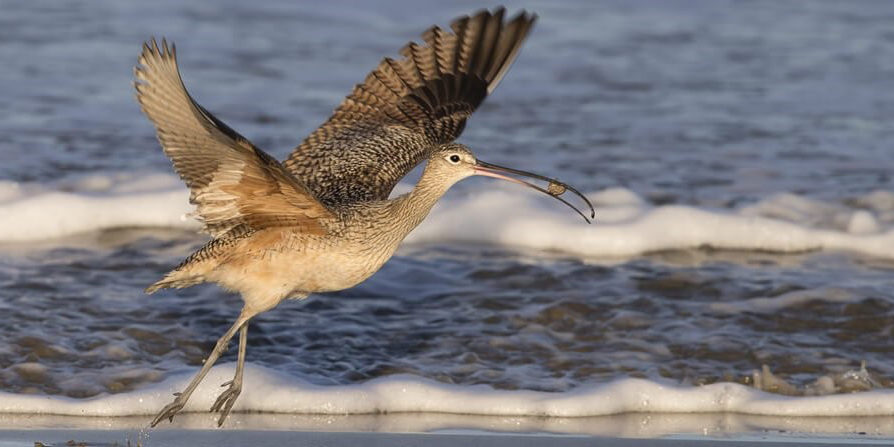Bird of The Week: Long-billed Curlew
SCIENTIFIC NAME: Numenius americanus
POPULATION: 140,000
TREND: Decreasing
HABITAT: Breeds in open grasslands; winters in estuaries, wetlands, and grasslands
The eye-catching Long-billed Curlew is North America’s largest shorebird, but like the Mountain Plover and Buff-breasted Sandpiper, it’s very often found away from the shore.
Its genus Numenius is named from the Greek word noumenios, meaning “of the new moon” — bestowed upon curlews because their long, curved bills were thought to resemble a sickle-shaped new moon.
The birds’ lengthy bills, longest in females, also engendered some interesting folk names such as “sicklebird,” “old smoker,” and “candlestick bird.”
Curlews of San Francisco
Candlestick Point and Candlestick Park stadium in San Francisco were both named after the Long-billed Curlew, the “candlestick bird,” which was once numerous in the region and still winters, although in smaller numbers.
Other places within the Long-billed Curlew’s breeding range are named after this avian stand-out — Curlew Lake in South Dakota and Curlew Valley in North Dakota are just a few.
Goliath Grasspiper
The Long-billed Curlew breeds on the wide grasslands of the Great Plains and Great Basin of the western United States and southwestern Canada. It’s one of the earliest breeding shorebirds, returning from wintering grounds by mid-March. Adults leave breeding areas by mid-July, with the young following in mid-August. This species is a short- to medium-distance migrant, moving south in flocks to winter along the U.S. West Coast, south into Mexico, Guatemala, and Honduras. Small numbers winter in Florida and along the southeastern Atlantic shore.
Aerial Defenders
A male Long-billed Curlew stakes out a breeding territory and attracts a mate through noisy flight displays, ascending to about 30 feet on rapid wingbeats, then slowly descending in circles while whistling an onomatopoeic “curl-e-e-u-u.”
Another commonly heard Long-billed Curlew vocalization is a call often given when a bird is alarmed, a sharp “whit-whit, whit, whit, whit, whit.’
Once mated, a male curlew fashions a nest scrape, or several. He may scratch out a few, but the female chooses one final site, lining her chosen nesting place with twigs, grasses, and leaves. The scrape is often placed next to an object, such as a rock, a shrub, or even a cow dropping.
Both parents incubate the eggs, of which there are most commonly four. Like the American Golden-Plover and Piping Plover, adult Long-billed Curlews may defend their eggs and young by feigning injury to lead away potential predators. Adults will also chase and attack intruders, including Swainson’s and Ferruginous Hawks, ravens, crows, coyotes, and people.
Downy young curlews leave the nest soon after hatching. At first, both parents tend the growing chicks, but after a few weeks, the female usually leaves the brood to the male and is the first to head south for the wintering grounds.
Incredi-Bill
Like many shorebirds such as the Sanderling and Ruddy Turnstone, the Long-billed Curlew often feeds in small flocks, particularly during migration and in winter. This bird’s extremely long, down-curved bill is perfectly adapted for probing after deep-burrowing prey such as earthworms, mollusks, and crabs, their chief food during the winter. During the summer, this species searches the ground and low foliage for insects such as grasshoppers, beetles, and butterflies. Its unmatched bill also comes in handy for reaching down wolf spider burrows. Curlews may even prey upon the eggs and young of smaller nesting birds such as the Horned Lark.
Conservation North and South
Once nearly wiped out by market hunting (with the sparse East Coast-wintering population yet to recover), the principal threat to the Long-billed Curlew is now habitat loss. Agricultural fields and housing developments have replaced many native grasslands, while non-native, invasive plants make some remaining habitat unsuitable for curlew nesting. Pesticide use poses another major threat to this species because these chemicals may greatly diminish food sources like grasshoppers, and perhaps directly threaten birds.
ABC is involved with a number of projects aimed at delivering full-life-cycle conservation for the Long-billed Curlew. Through the BirdScapes program, 12 focal areas were identified on the species’ North American breeding grounds, where ABC promotes best management practices for these birds. ABC and partners cooperate with farmers, ranchers, and government agencies on actions to help breeding curlews and other species of concern such as the Chestnut-collared Longspur.
Locally
Long-billed curlews can be found regularly in Morro Bay and the shore towards Cayucos.
Sources: American Bird Conservancy (abcbirds.org)


